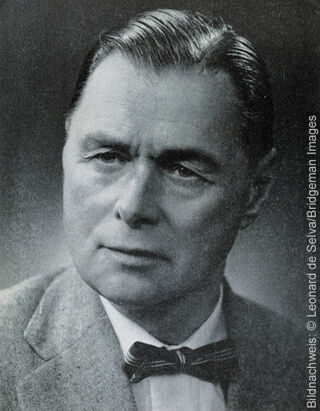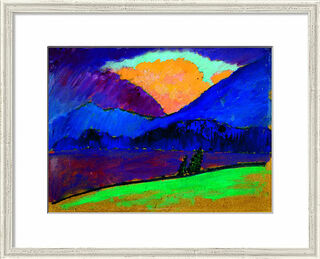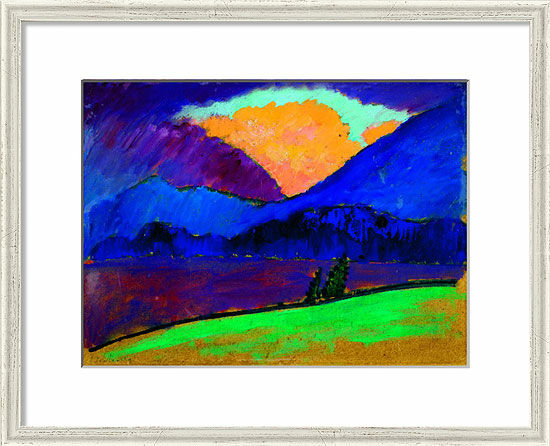Picture "Summer Evening in Murnau" (1908-09), framed


Picture "Summer Evening in Murnau" (1908-09), framed
Quick info
limited, 1,000 copies | facsimile print on handmade paper | framed | glazed | size 52 x 64 cm (h/w)
Detailed description
Picture "Summer Evening in Murnau" (1908-09), framed
Alexej von Jawlensky remains true to his unmistakable style of painting with this picture he created around 1908 in Murnau, with its bright and pure colours and its high-contrast, large-scale style of painting.
5-colour facsimile print on 270g Rives handmade paper. Limited edition of 1,000 copies. Framed in a silver-coloured solid wood frame, glazed. Size 52 x 64 cm (h/w).
Customer reviews
Gute Kopie des Bildes, gute Rahmung. Sehr zufrieden.

About Alexej von Jawlensky
1864-1941, German-Russian painter
It was not until 1889 that the former Russian Imperial Guard Alexej von Jawlensky in the Tsarist army began his artistic training. In 1896, he moved to Munich to attend a private art school where he met Wassily Kandinsky. In Murnau Jawlensky first worked together with Kandinsky and Gabriele Münter. And together they founded the Artist's Association "Neue Künstlervereinigung München". In addition, Jawlensky was a key member of the "Blauer Reiter" movement. He later co-founded the group "The Blue Four" with Klee, Kandinsky and Feininger.
Expelled from Germany as a Russian citizen in 1914, during the beginning of World War l, the artist settled in Switzerland and later in Wiesbaden, Germany. During this time he created his famous abstract heads. Jawlensky died of a serious illness in 1941.
"My art is meditation or prayer in colours", Jawlensky once said, and indeed his work is characterised by great religiousness. This is particularly noticeable in the series of works of the Saviour’s faces and the abstract heads, which Jawlensky summarises in his memoirs as "saints' heads". The influence of orthodox iconography is unmistakable, and they were already understood as a modern version of the icon by contemporary artist colleagues. The human face in many variations – mostly in strong, even bright colours – had already been a focus of his work before. With the saints' heads, he became more restrained in colour and reduced the subject of the portrait to the face itself. They seem de-individualised without losing expressiveness. A progressive abstraction, lead to an iconic form, which in the sequence seem like a search for an unattainable divine archetype.
Influenced by Fauvism, Alexej von Jawlensky painted with bright colours, fierce brushwork and dark outlines. His works are among the most sought-after works of classical modernism and can be found in the world's great museums.
The German artists‘ association "Der Blaue Reiter" ("The Blue Rider") was founded in Munich in 1911 by Wassily Kandinsky and Franz Marc during the German Expressionist period.
The name was originally the title of the painting by Kandinsky and also the title of the almanac published by Kandinsky and Marc. Members included Paul Klee and August Macke. The group criticised the prevailing art canon as too academic and elitist and demanded more openness and diversity. The artists turned away from realism and began to paint expressively in an increasingly abstract style using strong colours.
The group disbanded at the beginning of World War I.
Artistic movement that replaced Impressionism in the early 20th century.
Expressionism is the German form of the art revolution in painting, graphic art and sculpture, which found its precursor in the works of Paul Cézanne, Vincent van Gogh and Paul Gauguin in the late 19th century. The Expressionists attempted to advance to the primal elements of painting. With vibrant, unbroken colours in large areas and with the emphasis on the line and the resulting targeted suggestive expressiveness, they fought against the artistic taste established by the bourgeoisie.
The most important representatives of Expressionism were the founders of "Die Brücke" (The Bridge): Ernst Ludwig Kirchner, Erich Heckel, Karl Schmidt-Rottluff, Max Pechstein, Otto Mueller and Franz Marc, August Macke and others.
Masters of Viennese Expressionism are Egon Schiele and Oskar Kokoschka. Among the sculptors, Ernst Barlach is the most famous.
Fauvism is the French form of Expressionism.
Latin: "to make alike".
Largely faithful reproduction of an original document, e.g. old manuscripts and codices. (Facsimile edition).


